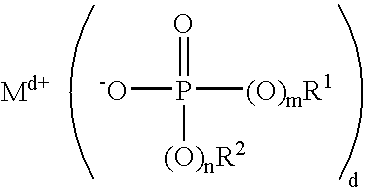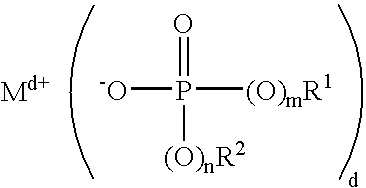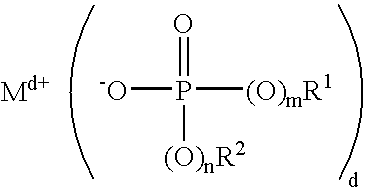Polymer composition, method, and article
a technology of polymer composition and composition method, applied in the field of plastics industry, can solve the problem that high concentrations detract from the desired physical properties of the plastic composition
- Summary
- Abstract
- Description
- Claims
- Application Information
AI Technical Summary
Benefits of technology
Problems solved by technology
Method used
Image
Examples
examples 1-4
, COMPARATIVE EXAMPLES 1-7
[0096]These examples and comparative examples illustrate the flame retardant synergy of a phosphorus salt and a phosphine compound according to the invention. All compositions included 47.5 parts by weight triallyl isocyanurate (“TAIC”), obtained from Degussa Corporation; 27.2 parts by weight of a methacrylate-capped poly(2,6-dimethyl-1,4-phenylene ether) (“MA-PPE”) having an intrinsic viscosity of 0.12 dL / g, prepared according to the method of U.S. Pat. No. 6,384,176 to Braat et al.; and 25.3 parts by weight of glass fiber having a diameter of about 14 micrometers and an initial length of about 4 millimeters, obtained as 497-14C from Owens-Corning. The samples varied in their flame retardant types and amounts. Comparative Example 1 contained no flame retardant. Comparative Examples 2-4 contained increasing amounts of aluminum tris(diethylphosphinate) (“Al(OPEt2)3”), obtained as OP930 from Clariant. Comparative Examples 5-7 contained increasing amounts of a...
examples 5-14
, COMPARATIVE EXAMPLES 8-10
[0099]These examples illustrate that the synergistic effect demonstrated in the previous examples is also obtained when triphenylphosphine oxide is used as the phosphine compound. Triphenylphosphine oxide (“TPPO”) was obtained from Sigma-Aldrich. Compositions were prepared, molded, and tested as described above. Compositions and results are presented in Table 2 (which reiterates the results of Comparative Examples 1-4). The results again show that the phosphate salt and phosphine compound are both mildly effective flame retardants, and that the combination of the phosphate salt and phosphine compound is an extremely effective flame retardant. For example, Comparative Example 4 (11.11 pbw Al(OPEt2)3), Comparative Example 10 (11.11 pbw TPPO), and Example 6 (5.56 pbw each of Al(OPEt2)3 and TPPO) all have the same total amount of flame retardant, but the respective flame out times are 44.1, 91.1, and 18.6 seconds, respectively. Examples 8-14 further illustrate...
examples 15-54
, COMPARATIVE EXAMPLES 11-17
[0101]These examples describe the fabrication of laminates using the curable composition. Laminates were prepared by impregnating glass cloth (17.78 centimeters (7 inches) by 19.05 centimeters (7.5 inches)) with a toluene solution of resin and flame retardant. After mixing the resin solution for 30 minutes, the resin solution was heated to 65° C. for 15-30 seconds. After two cycles of dipping the glass cloth, the glass cloth was dried overnight by evaporation to obtain about 50 weight percent impregnated curable composition (i.e., a “prepreg”). Laminates were produced by stacking several prepregs, compression molding for four minutes at a temperature of 150-180° C. at a pressure of 13.34 kilonewtons (3000 pounds), and cooling for three minutes in a hot press. The average thickness for each laminate was determined using a micrometer. Average first flame out times and average second flame out times were determined according to UL 94.
[0102]Compositions are p...
PUM
| Property | Measurement | Unit |
|---|---|---|
| weight percent | aaaaa | aaaaa |
| temperature | aaaaa | aaaaa |
| length | aaaaa | aaaaa |
Abstract
Description
Claims
Application Information
 Login to View More
Login to View More - R&D
- Intellectual Property
- Life Sciences
- Materials
- Tech Scout
- Unparalleled Data Quality
- Higher Quality Content
- 60% Fewer Hallucinations
Browse by: Latest US Patents, China's latest patents, Technical Efficacy Thesaurus, Application Domain, Technology Topic, Popular Technical Reports.
© 2025 PatSnap. All rights reserved.Legal|Privacy policy|Modern Slavery Act Transparency Statement|Sitemap|About US| Contact US: help@patsnap.com



